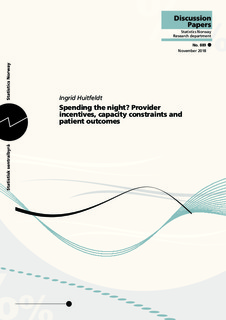Spending the night. Provider incentives, capacity constraints and patient outcomes
Working paper
Published version
Permanent lenke
http://hdl.handle.net/11250/2627472Utgivelsesdato
2018-11Metadata
Vis full innførselSamlinger
- Discussion Papers [1003]
Sammendrag
Healthcare providers’ response to payment incentives may have consequences for both fiscal spending and patient health. This paper studies the effects of a change in the payment scheme for hospitals in Norway. In 2010, payments for patients discharged on the day of admission were substantially decreased, while payments for stays lasting longer than one day were increased. This gave hospitals incentives to shift patients from one-day stays to two-day stays, or to decrease the admission of one-day stays. I study hospital responses by exploiting the variable size of price changes across diagnoses in a difference-in-differences framework. I find no evidence that hospitals respond to price changes, and capacity constraints do not appear to explain this finding. Results imply that the current payment policy yields little scope for policymakers to affect the healthcare spending and treatment choices. Denne artikkelen studerer effektene av en endring i finansieringssystemet for norske sykehus. I 2010 ble sykehusenes kompensasjon for dagbehandling drastisk redusert, mens kompensasjonen for døgnbehandling ble økt. Dette ga sykehusene insentiver til å flytte pasienter fra dagbehandling til døgnbehandling, eller til å redusere antall dagbehandlinger. Slike tilpasninger til økonomiske insentiver kan ha konsekvenser både for offentlige finanser og for pasienters helse. Artikkelen utnytter variasjon mellom diagnosegrupper i størrelsen på marginalgevinsten av å legge inn pasienten for å undersøke om sykehus responderer på insentivendringene. Resultatene viser at sykehus ikke responderer på endringene i insentiver, og det ser ikke ut til at mangel på ledige sengeplasser forklarer hvorfor pasienter ikke flyttes fra dagbehandling til døgnbehandling. Disse funnene indikerer at dagens finansieringsmodell gir lite rom for at økonomiske insentiver kan påvirke behandlingsvalg og ressursbruk i helsetjenesten
